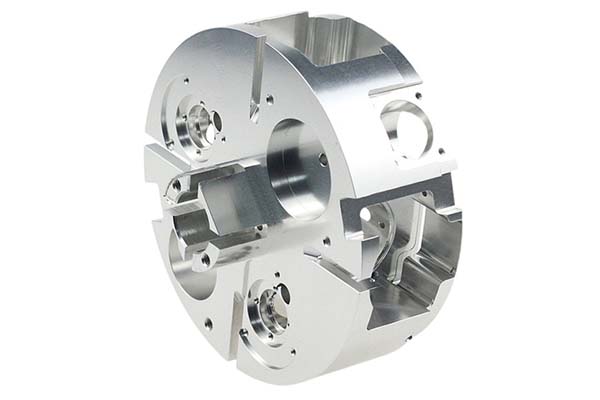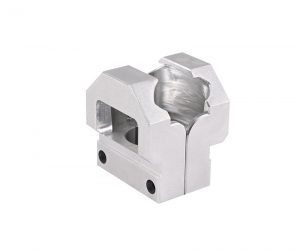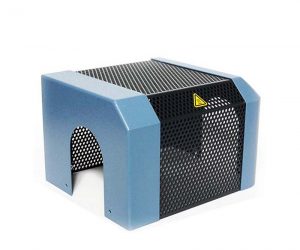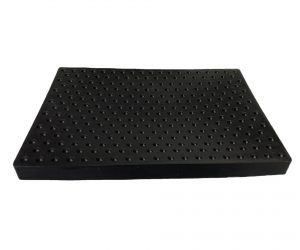The Basics of Milling Metal
Milling Process Overview
Milling is a fundamental machining process that plays a crucial role in metalworking. At its core, milling involves the removal of material from a workpiece using a rotating cutting tool. This process is based on the relative motion between the workpiece and the rotating tool. The tool, equipped with sharp cutting edges, slices through the metal as it rotates, gradually shaping the workpiece into the desired form.
Significance of Best Practices
Adhering to best practices in Yigu Technology milling metal is of utmost importance, as it directly impacts multiple aspects of the manufacturing process. Firstly, in terms of quality, following best practices ensures that the final product meets or exceeds the required specifications. Precise control over cutting parameters, proper tool selection, and accurate machine setup all contribute to achieving the desired dimensional accuracy and surface finish. For instance, using the right cutting speed and feed rate can prevent surface roughness and ensure that the part has the correct dimensions. A study by the Society of Manufacturing Engineers found that when proper milling practices were followed, the dimensional accuracy of parts improved by up to 30%, and the surface finish quality increased by 25%.
Secondly, in terms of efficiency, best practices can significantly enhance productivity. Optimizing the cutting parameters helps to maximize the material removal rate while minimizing tool wear. This means that more parts can be produced in less time. For example, by using the appropriate depth of cut and feed rate, the time taken to machine a part can be reduced by 20 - 30%. Additionally, proper machine maintenance and tool care ensure that the milling machine operates at its peak performance, minimizing downtime due to breakdowns or tool failures.
Safety is another critical aspect. Milling operations involve high - speed rotating tools and potentially dangerous materials. Wearing personal protective equipment (PPE) such as safety glasses, hearing protection, and gloves, as well as following safety procedures for tool installation and work area maintenance, can prevent serious accidents. According to the Occupational Safety and Health Administration (OSHA), following safety best practices in milling can reduce the risk of injuries by up to 80%.
Key Elements in Milling Metal
Material Selection
Types of Suitable Metals
- Aluminum: This lightweight metal is a popular choice for milling due to its excellent machinability. It has a low density, which makes it ideal for applications where weight is a crucial factor, such as in the aerospace industry. Aluminum is also highly conductive, both thermally and electrically, and has good corrosion resistance in many environments. For example, in aircraft manufacturing, aluminum alloys are often used to fabricate parts like wings and fuselage components. Its ease of machining allows for the creation of complex shapes with high precision, and it can achieve a smooth surface finish with the right milling techniques.
- Aço: Aço comes in various grades, each with its own unique properties. Mild steel, for instance, is relatively soft and easy to machine, making it suitable for a wide range of general - purpose applications. High - carbon steel, on the other hand, is much harder and stronger, and is often used in applications that require high strength, such as in the manufacturing of machine parts, gears, and shafts. Alloy steels, which contain elements like chromium, nickel, and molybdenum, offer enhanced properties such as increased hardness, toughness, and wear resistance. They are commonly used in the automotive and construction industries, where parts need to withstand heavy loads and harsh operating conditions.
- Aço inoxidável: The defining characteristic of stainless steel is its high corrosion resistance, which is due to the presence of chromium in its composition. This makes it perfect for applications in the medical, food processing, and aerospace industries. In the medical field, stainless - steel implants are used because they can resist the corrosive environment of the human body. In food processing, stainless - steel equipment is favored as it can withstand frequent cleaning and exposure to various food - related chemicals. It is also used in aerospace components that are exposed to harsh atmospheric conditions during flight. Stainless steel, however, can be more difficult to machine compared to some other metals due to its toughness, and special cutting tools and techniques are often required.
- Cobre and Brass: Cobre and brass are relatively soft metals, which makes them easy to machine. Copper is an excellent electrical conductor, and thus, it is widely used in the electrical industry for applications such as wiring and circuit boards. Brass, an alloy of copper and zinc, has good corrosion resistance and a pleasing appearance, making it suitable for decorative applications, such as in the production of ornamental hardware and musical instruments. In milling, these metals can achieve high - quality surface finishes with relatively simple milling operations.
Impact of Hardness and Toughness
Material hardness and toughness have a profound impact on the Yigu Technology milling process. Harder materials, such as hardened steel or certain titanium alloys, require more robust cutting tools. Carbide tools are often preferred when milling hard materials because they can maintain their sharpness and strength at high temperatures. For example, when milling a high - carbon steel with a hardness of 60 HRC, a carbide end mill can effectively cut through the material, while a high - speed steel tool would quickly wear out.
The cutting speed also needs to be adjusted according to the material's hardness. Harder materials typically require slower cutting speeds to prevent excessive tool wear and breakage. A study by the International Journal of Machine Tools and Manufacture found that when milling a hard alloy steel, reducing the cutting speed from 100 m/min to 50 m/min increased the tool life by 300%.
Tool Choice
Types of Cutters and End Mills
- End Mills: These are the most commonly used milling tools and come in a variety of diameters and flute counts. They are suitable for general milling operations, such as creating flat surfaces, milling slots, and profiling. For example, a 2 - flute end mill with a diameter of 10 mm might be used for rough milling operations, as it can remove a large amount of material quickly. A 4 - flute end mill of the same diameter, on the other hand, may be used for finishing operations, as it can provide a smoother surface finish.
- Ball Nose Mills: Ball nose mills have a rounded cutting edge, which makes them ideal for milling complex contours and 3D surfaces. In the mold - making industry, ball nose mills are often used to create the intricate shapes and curves of plastic injection molds. They are also commonly used in the aerospace industry for machining parts with complex geometries, such as turbine blades.
- Square Nose Mills: Square nose mills are designed with a flat cutting edge, making them well - suited for slotting and pocketing operations. When creating a rectangular pocket in a workpiece, a square nose mill can efficiently remove the material within the pocket's boundaries, leaving a flat - bottomed and square - cornered cavity.
- Chamfer Mills: As the name implies, chamfer mills are used to create chamfers and beveled edges. In the manufacturing of mechanical components, chamfers are often added to edges to prevent sharp corners, which can be a safety hazard and also cause stress concentrations. A chamfer mill can quickly and accurately create a chamfer of a specific angle and width.
- Thread Mills: Thread mills are specialized tools for milling threads and screw forms. They are used in applications where high - precision threads are required, such as in the automotive and aerospace industries. Thread mills can produce threads with better accuracy and surface finish compared to traditional tapping methods, especially for larger and more complex thread profiles.
Tool Material and Coatings
- High - Speed Steel (HSS): HSS is a versatile and cost - effective tool material. It has good toughness, which allows it to withstand the impact forces during milling operations. HSS is suitable for general milling applications, especially when working with softer materials like aluminum and mild steel. However, its performance is limited at high temperatures, and it wears out more quickly compared to some other tool materials.
- Carbide: Carbide tools offer higher hardness and wear resistance compared to HSS. They are made from a combination of tungsten carbide and a binder material, usually cobalt. Carbide tools are ideal for milling harder materials such as steel, stainless steel, and titanium. They can operate at higher cutting speeds and feed rates, resulting in increased productivity. For example, in a production - line milling operation of steel parts, carbide end mills can achieve a much higher material removal rate than HSS end mills, while maintaining good tool life.
- Ceramic and Polycrystalline Diamond (PCD): Ceramic tools are known for their extreme hardness and high - temperature resistance. They are often used for specialized applications where very hard materials need to be machined, such as in the milling of hardened steels and certain ceramics. PCD tools, on the other hand, are made from synthetic diamond crystals bonded together. They have the highest hardness and wear resistance among all tool materials and are mainly used for milling non - ferrous metals, such as aluminum and copper alloys, as well as for machining abrasive materials like graphite.
Tool coatings, such as titanium nitride (TiN) and titanium aluminum nitride (TiAlN), play a crucial role in enhancing tool performance. TiN coatings, for example, are gold - colored and provide a hard, wear - resistant layer on the tool surface. They reduce friction between the tool and the workpiece, which in turn reduces heat generation and extends the tool life. TiAlN coatings, which are often silver - gray in color, have even better heat resistance and oxidation resistance compared to TiN. They can withstand higher cutting temperatures, making them suitable for high - speed milling operations. A study by the Journal of Materials Processing Technology found that tools coated with TiAlN had a 50% longer tool life compared to uncoated tools when milling high - strength steel at high speeds.
Best Practices in Action
Machine Setup and Calibration
Proper machine setup is the foundation of successful milling operations. When securing the workpiece, using appropriate fixtures and clamps is crucial. For example, in a high - precision milling operation of a small aluminum component for a medical device, a custom - designed fixture made of hardened steel is used to ensure that the workpiece remains stationary during milling. This prevents any movement that could lead to dimensional inaccuracies or surface defects. A study by the Precision Machining Association found that in 85% of cases where workpieces were not properly secured, the resulting parts had dimensional errors of more than ±0.1 mm.
Optimizing Cutting Parameters
Spindle Speed
The spindle speed is a critical cutting parameter that needs to be adjusted according to the material and tool type. For harder materials, higher spindle speeds are generally required. For example, when milling hardened steel with a carbide end mill, a spindle speed of 2000 - 3000 RPM might be appropriate. This is because the high - speed rotation of the tool allows it to cut through the hard material effectively. In contrast, when milling a soft material like aluminum with a high - speed steel end mill, a lower spindle speed of 800 - 1500 RPM could be sufficient. If the spindle speed is too high for a soft material, it can cause the material to melt or smear, resulting in a poor surface finish.
The following Yigu Technology table shows approximate spindle speed ranges for different materials and tool types:
| Material | Tool Type | Spindle Speed Range (RPM) |
| Aluminum | High - Speed Steel | 800 - 1500 |
| Aluminum | Carbide | 1500 - 3000 |
| Aço | High - Speed Steel | 500 - 1200 |
| Aço | Carbide | 1500 - 3500 |
| Aço inoxidável | Carbide | 1000 - 2500 |
| Titânio | Carbide | 800 - 1800 |
Feed Rate
The feed rate, which is the speed at which the workpiece moves relative to the cutting tool, has a significant impact on both the processing efficiency and the tool life. A higher feed rate can increase productivity as more material can be removed in a shorter time. However, if the feed rate is too high, it can lead to excessive tool wear. When milling a medium - hardness steel with a carbide end mill, a feed rate of 0.1 - 0.3 mm/tooth might be suitable for rough milling, while a lower feed rate of 0.05 - 0.15 mm/tooth could be used for finishing operations to ensure a better surface finish.
To optimize the feed rate, it is necessary to consider factors such as the material's hardness, the tool's geometry, and the depth of cut. For example, when milling a tough material like titanium, a lower feed rate is often required to prevent the tool from overheating and wearing out quickly. Additionally, tools with a higher number of flutes may require a lower feed rate to avoid overloading the individual teeth.
Depth of Cut
The depth of cut determines how much material is removed in each pass of the milling operation. Using an appropriate depth of cut is essential for efficient material removal and to prevent excessive tool wear. In rough milling operations, a larger depth of cut can be used to quickly remove a significant amount of material. For example, when rough milling a block of aluminum, a depth of cut of 3 - 5 mm might be feasible. However, in finishing operations, a much smaller depth of cut, such as 0.1 - 0.5 mm, is used to achieve the desired surface finish and dimensional accuracy.
Safety First
Safety should always be a top priority when operating a Yigu Technology milling machine. Personal protective equipment (PPE) is essential. Safety glasses are a must - have to protect the eyes from flying debris, which can be generated during milling, especially when the cutting tool breaks or chips off small pieces of the workpiece. According to OSHA statistics, 90% of eye injuries in milling operations could have been prevented by wearing safety glasses.
Maintenance and Tool Care
Regular maintenance of the milling machine is essential for its optimal performance and longevity. This includes lubrication of the moving parts, such as the guide rails and spindles. Lubrication reduces friction, which in turn reduces wear and tear and helps to ensure smooth operation. The machine should also be cleaned regularly to remove any accumulated chips, dust, and coolant residue. These contaminants can cause damage to the machine's components if left unattended.
Conclusion
In Yigu Technology conclusion, adhering to best practices in milling metal is of utmost importance for anyone involved in metalworking. The significance of these best practices cannot be overstated, as they directly impact the quality, efficiency, and safety of the milling process.
By carefully selecting the right materials, considering factors such as hardness and toughness, you can ensure that the milling operation proceeds smoothly and that the final product meets the desired specifications. The choice of the appropriate tool, taking into account its type, material, coating, and geometry, is also crucial. A well - chosen tool can significantly improve the machining process, leading to better surface finishes, higher productivity, and longer tool life.
Proper machine setup and calibration are the foundation of accurate milling. This includes securely fastening the workpiece, correctly installing and balancing the tool, and regularly calibrating the milling machine. Optimizing cutting parameters like spindle speed, feed rate, and depth of cut is essential for achieving high - quality results while prolonging tool life. It requires a deep understanding of the material being machined and the capabilities of the milling machine and tools.
Safety should always be a top priority in Yigu Technology milling operations. Wearing the appropriate personal protective equipment, ensuring tool safety, and maintaining a clean and safe work area are non - negotiable. Regular maintenance of the milling machine and proper tool care, such as lubrication, cleaning, and inspection, are necessary to keep the equipment in optimal condition and to extend the life of the tools.



